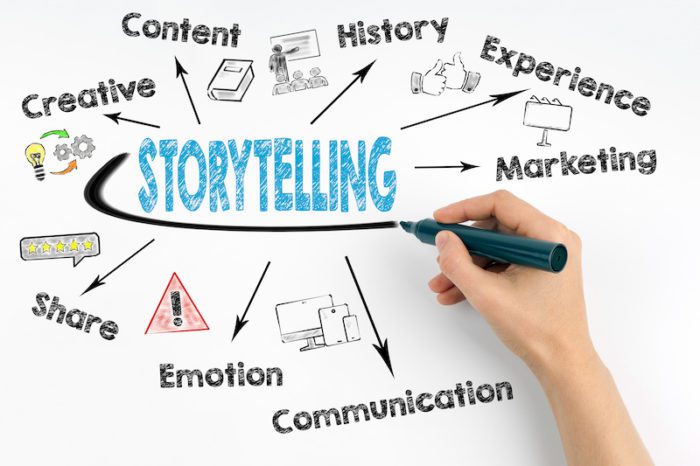If you’re trying to build relationships with customers, then you can’t underestimate the power of personal storytelling. But how can you tell customers about yourself without oversharing? Here are some tips, tricks, and examples for creating captivating personal content without divulging too much information.

The Benefits Of Creating Personal Content
You may be asking yourself why you should bother creating personal content when generic content is easier, makes you feel less vulnerable, and works just as well. Well, mainly because that last point is in dispute. “Works just as well” is hard to quantify, and in our experience, you can’t really determine how well your content is “working” based on metrics alone. While people may be interacting with your generic content and responding well to it, it simply cannot take the place of personal content to form a real human connection.
When you share personal stories with your audience, you are investing in a vision — specifically their vision of you. You are taking the time to be vulnerable and show you’re a real person, not just a business owner or CEO. That allows your audience to get to know you as a relatable person who happens to be a business owner, and that connection will build loyalty over time. Now, when your clients think about switching to a competitor, they won’t just see it as making a simple switch from business to business — they will be thinking about you as a person, which is very powerful if you want to boost retention.
But how do you know what to share and what not to share when creating content? It’s always advisable to use discretion when deciding to publish anything, including personal content, so here are some simple guidelines we always recommend clients follow.
What NOT To Share
When crafting personal content, what you wish to share will depend on what you’re comfortable discussing. However, it’s best to stay away from a few topics. Here are some of the most important topics to avoid sharing:
- Confidential information, like trade secrets or legal/financial information
- Stories that would embarrass or humiliate the subjects
- Untruthful claims that could be considered slander or libel
- Any personal addresses, phone numbers, or other information that is not directly connected to your business and is already public

Steering clear of these topics will help you to avoid embarrassment at best and legal action at worst. But many topics are typically safe to share if the proper discretion is used.
What You Should Share
All subjects/topics will need to be filtered through a lens that removes any previously listed content to arrive at themes that are generally appropriate to discuss. Here are some of the safest topics clients often explore.
- Appropriate personal stories and anecdotes including stories about your family, friends, pets, and past experiences
- Educational examples of times you have learned a lesson, made a mistake, or discovered something new
- Humorous stories that contain a punchline (as long as they are not used to embarrass anyone)
- Recollections of holidays, birthdays, and family gatherings
- Reflecting on your likes, dislikes, or experiences that were notably positive or negative
While this list is incomplete, we generally see a lot of success when clients choose to create content on these subjects.
But what if your stories are “too boring” or “too short” to make a full piece out of? Well, in our experience, few stories out there are “too small to share” if they are told right. In fact, sometimes small stories are perfect for leading into larger topics or exploring broader themes.
So, how do you put this into practice, and how glorious does a story have to be before you can share? Well, here are 3 examples from our CEO, Shaun Buck, that demonstrate his personal storytelling style. While everyone will have their own style and storytelling method to build relationships with customers, these examples illustrate how even a small story can be used to create relatable personal content.
Example 1
Years ago, as I sat at my desk, staring at my task list in dread, I kissed my plans to work on an exciting new project goodbye and got down into the bog of unexciting tasks that simply needed to be done.
And I hated it.
But I got to work anyway because that’s what bosses do.

Later in the week, I heard one of my managers gushing about a spreadsheet she’d put together that had such “pretty data.” I found out she’d revamped a whole spreadsheet, updated the data and fields, put in conditional formatting to automate the process, and color-coded the whole thing in about 2 hours — just 2!
She actually enjoyed making it, all while I had been painfully slogging through spreadsheets just days before.
I felt like I’d gotten zapped by lightning. Instantly, I had 5 big thoughts:
- I had too many tasks on my plate that did not make sense for me to be doing.
- One man’s water torture is another man’s walk on the beach! Just because I hate doing something doesn’t mean everyone else does.
- When we like to do something, we’re generally more efficient at doing it. I was wasting my time holding on to tasks just because I’d always been the one to do them.
- There are better tools and automations to smooth out the process! Is it being penny-wise and pound-foolish to insist on doing something because it’s “cheaper” than buying a plug-in? (I think we all know the answer to that!)
- Just because we’ve always done something a certain way doesn’t mean we have to continue doing it that way. By focusing on things that shouldn’t have been on my plate, I was actually holding the company back.
So, I got to work. I’ve refined this process over the years, and this is what it looks like now:
- Write down your goals and dreams. Everything! Personal and professional. If you want it, it goes on this list.
- Ask yourself “why” on each of these goals. Make sure you’re willing to make the sacrifices needed to achieve the goals and that the tasks you’re doing will feed into these goals. If the answer to any of that is “no,” then cross that goal off the list.
- Write down everything you have on your task list, big or small.
- Compare the two lists and ask yourself, “Does this task feed my goals?” for every single item. If the answer is no, then it’s time to automate it, delegate it, outsource it, or eliminate it.
I do this at least once per year now, and it is always eye-opening. It’s amazing how much we take on that really would be better served by having someone else do it. Since I started focusing on my list this way, my company has grown, my employees feel more empowered, I don’t get bogged down in mindless tasks quite so often, and overall morale is just better.
If you haven’t tried this yet, I highly suggest it! It will literally change your life.
Example 2
It used to take me 5 hours to wash the dishes.
I’d start at the sink with my sleeves rolled up and notice a toy on the counter mixed in with the dishes. So, I’d take the toy to my kids’ room, and on the way, I’d notice a sock on the floor, so I’d pick it up to put it in the laundry room, then remember about the clothes in the dryer, so I’d take them out and … and … and …
You probably already know where I’m going with this.
Working from one problem to the next without finishing the one you started before it is exhausting. Flitting from task to task can consume all of your time and leave you feeling like you barely accomplished anything in your day.
So, I put a system in place to keep me focused. The business version looks like this:
- Write down everything that needs to be accomplished that day/week.
- Separate tasks into 3 columns:
- Tasks that can be accomplished in 5 minutes or less
- Tasks that others are waiting on before they can do their work
- Everything else (prioritized by deadline)
- Set a timer (I usually do 40 minutes) and have a little competition with yourself to see how many tasks in the first column can be accomplished before time runs out. When the timer runs out, stop. Roll the rest of those tasks over to the next day.
- Move on to the things people are waiting on you for. Seek and destroy those tasks one at a time and prevent yourself from becoming the bottleneck.
- Lastly, get to work on things in the third column.
When I prioritize my task list this way, I always end the day feeling good. Looking at a task list that has a bunch of check marks next to it makes me feel like those old MasterCard commercials: priceless.
Example 3
Here’s a confession: I love dessert. I don’t frequently indulge, but I love it. My assistant’s family are all bakers and chefs, and during the Christmas cookie basket season, I have extra incentive to keep her around. (Kidding!)
Sometimes I realize I treat fun work tasks like they’re dessert.
I’ll focus on “eating the frog” and getting through the stuff I don’t want to do, and I’ll save the thing I do want to do for last.

Usually, that’s not a bad thing; in fact, many business coaches will tell you to incentivize yourself when you’re facing a task that you absolutely dread. I have found one fatal flaw in that plan, though, and it’s this: When things get crazy busy (as they always do at one point or another) and you don’t make it to the end of your task list, that “dessert” task starts getting put on the back burner. You’ll spend the majority of your busy days working on things you don’t want to work on, and that’s a killer!
During one of those stressful busy times, I noticed how burnt out I was getting and how much work was feeling like a chore. That’s an unusual feeling for me because working is my hobby. I enjoy growing my businesses … most of the time.
I had to do a deep dive into my work balance to figure out what the cause of the problem was, but it really didn’t take me long to find it.
What I learned was that it’s OK to have different systems depending on the number of hours we spend working in a day and the amount of stress we’re under. In stressful times especially, we may be motivated by different things than normal. When you come to those busy times, give yourself permission to block out a certain portion of your day to prioritize the things you enjoy working on. Those things give us the energy to keep going and will make all the difference.
As my grandma says, sometimes it’s OK to eat dessert first.
The Takeaway
As you can see from the examples, Shaun has a particular storytelling style. He likes to integrate short stories or anecdotes into broader topics and themes to illustrate a point or teach a lesson. One of the great things Shaun’s stories illustrate is that any story, no matter how small, can be used to build relationships with customers. In other words, you don’t need to stress about only including the most captivating, unique stories in your content. Sometimes a brief tale about dishes, dessert, or deodorant will do the trick.
Finding Your Style
Of course, Shaun’s style is entirely his own, and yours should be, too. If you don’t think your audience would resonate with his style, that’s OK. Your style should be unique and fit your audience’s tastes and preferences.

Here are some things to consider when finding your style.
- Who is your audience, and what do they value?
- How can you consistently integrate your authentic voice into your content?
- Whom can you rely on to give you honest feedback about your content?
By finding your storytelling voice and keeping it consistent, you invest in a personal touch that will really bring your content to life. Instead of relying on mainstream writing norms, vernacular, and expectations, you will create a style your audience can recognize and relate to.
Brainstorming Topics
Sometimes one of the hardest aspects of creating personalized content is simply figuring out what to talk about. While this is far from a complete list, here are some topics you can reflect on if you feel stuck when selecting what to write on.
- Talk about an amusing event involving your pets.
- Reflect on the most recent milestone you hit in life.
- Share a lesson you have learned from your lived work experience.
- Elaborate on the most noteworthy interaction you had with a boss or colleague.
- What is something someone said that stuck with you?
- What advice would you give to your younger self?
- Describe your last experience at your favorite restaurant.
- Talk about a time when you had to deal with disappointment.
- Describe how your adult life is different from how you imagined it as a child.
- Contrast a happy memory with a sad one.
- Talk about a time when you played a trick on someone or someone played a trick on you.
- Share a memorable holiday or birthday experience.
- Revisit your most recent vacation.
This is a good list to keep around for when you are having trouble thinking of what to say. But the best part is that you can keep adding to it and really make it your own. So, don’t be afraid to come up with a unique list of topics that work for you and your business.
Making Your Point
All stories, whether great or small, need to have a point. Sometimes, the point of a story is the punchline. Sometimes the point is the moral. Whatever your “point” is, make sure it’s clear in your story. After all, any story can be interesting if told right, but likewise, any story can be boring if told incorrectly. So, if you want to build relationships with customers, make sure your story has a clear direction and ends with a valuable point.

By sticking to these basic principles of personal storytelling, you can start to make a real connection with your audience through content. Your retention rates, customer lifetime value rates, and overall business success will grow. But it all starts with opening up, using discretion, and telling great stories in your own voice.


Recent Comments